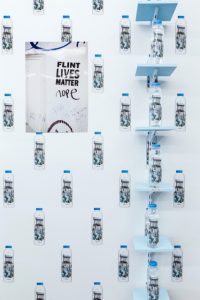IMMERSE
Art Visits
Last week, we kicked off our immersion into installation art and water consumption with some exhibit visits. We went to the Contemporary Arts Museum in the museum district and saw Brooklyn-based artist Christopher Knowles’s In a Word and collaborators Sunil Gupta and Charan Singh’s photo series Dissent and Desire, which focused on the experience of LGBTQ+ people in India. We enjoyed the exhibitions, discussed them afterwards, what we liked and didn’t, ideas that pieces gave us. A key observation we made about people’s museum habits and behaviors: typically, a group will split up to look at the art as individuals and then come back together to discuss it. We’ve also been visiting the juice boxes individually as a team. A few observations: the boxes are far a central corridor/quad, the field they’re in feels isolated, inside the containers can be really stuffy. Overall, independent of the piece that was in the juice box, my experience going wasn’t very pleasant.

Rice Solar Studios (Juice Boxes)
Research
On the research side of our work we’re getting closer to having a narrow problem space and a How Can We Statement. We reviewed examples of art installations that Manlin compiled. She did an excellent job finding pieces that were relevant to sustainability and water consumption. Lots of thoughts and ideas were thrown around and we’re getting a lot more excited to see what we can do. One that we found especially compelling for its activist nature was Pope.L’s Flint Water Project. He took the contaminated water in Flint, Michigan, branded, packaged, and sold it back to people. All the proceeds from the water went to helping solve the crisis.

We reviewed our research that we began in the identify stage and clustered the insights into categories based on potential themes and user groups. We researched five domains relating to our project: installation art, water consumption interventions, the state of water sustainability/conservation as an issue, Houston’s water consumption and conservation efforts, and the state of water sustainability as a movement. This provided us with a well-rounded set of insights to help break down the problem sets. We took five research insights from each research domain and clustered them on a whiteboard.

The goal of coming up with a theme is unique to this project. Typically a DFA project features a well-defined user with specific needs that can be assessed. However an art installation’s focus is not to directly solve the problem — the impact of art operates on an emotional and intangible level. Makes things hard for us. This project works on the line between art and design and it’s interesting for us to figure out what tools are useful from each discipline. A theme in this context is an example of a tool from fine art that we’re using in the design process. We’ll use these themes to help guide our problem space, brainstorming, and decision process — it gives us something to tie our reasons and ideas back to, much like a user would in a more typical DFA project.
The initial themes we chose to more forward with are Activism and (In)visibility. These are tentative and will be refined further as we figure out how they become useful and their meaning to us develops. The theme of Activism is focuses on responding to a specific instance of water waste or consumption in order to spark action. The theme of (In)Visibility is the idea of bringing your invisible consumption to your attention and making you more mindful of the far-reaching implication of your normative, destructive habits.
We also used a tool from human-centered design to help us at this point: user groups. Based on the insights we found, we chose two compelling user groups. The goal of defining user groups at this point is to help us align our message to a target audience through empathy. You would say different things to an individual to try to get them to curb their water consumption than you would to an institution like Rice University; that’s because they have different problems relating to water waste. We chose the user groups of the Rice University community, and administrative bodies (on- and off-campus).
That’s all we have for this week! We’ll be reframing in the upcoming weeks and then we get to BRAINSTORM!!!
